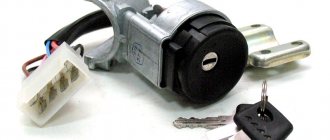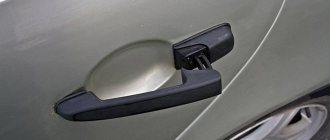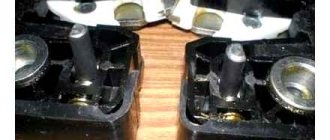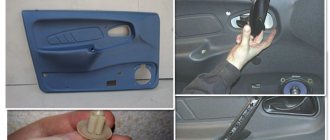Physics is not in your favor
The above problems occur due to the fact that in the cold, water turns into ice and “fetters” the lock mechanisms. It gets there either during washing, after which it is important to thoroughly blow out the openings and locks, or it accumulates on its own during operation - and at the most inopportune moment it turns out to be enough to cause problems for the motorist. The same applies to freezing door seals: you can either not get into the car or use excessive force and break the rubber bands. What to do to avoid these troubles?
They have already said about washing: it is necessary to blow through both the openings and the locks - their cylinders and the actual locking mechanisms located at the ends of the doors. Door seals and interior parts should be wiped dry and should not be left wet. If the situation is frosty, we recommend slamming the doors thoroughly half an hour to an hour after washing - this way you will “shake off” the ice that has just appeared and is not yet very strong.
The best remedy is prevention
The risk of problems can be significantly reduced by pre-treating the parts with suitable products. And here the choice will depend on the node. So, it is better to pour a little universal lubricant into the lock cylinders - mineral oil without additives. If there is no such thing on the farm, regular motor oil will do.
But it is better to treat door hinges and locking mechanisms with a special adhesive lubricant. The fact is that these parts have friction between each other; ordinary oil does not stay on them for a long time. Therefore, it is preferable to use special products that “stick” to materials and cannot simply be removed. In this case, it is better to use lubricants with Teflon additives, which will also prevent the adhesion of dust (these are used, for example, for motorcycle chains). An important point: these products are not suitable for treating larvae, because they can simply cause the secret parts of the mechanism to stick.
You may say: why such difficulties? Isn’t it easier to use a universal product like WD40? No! Even though the “Vedeshka” has cleansing properties and displaces moisture, it cannot be considered as a protective agent, it is too “dry” and additional lubrication is needed.
People's Council (tsiatim and litol)
If you take a substance called “cyatim-221” and mix it in the right proportion with machine oil, you will get a means to protect the lock in winter. By the words “the right proportion” this is what is meant: the cyatim itself looks like a thick gray-white grease. Oil is used to obtain the required consistency. And then, the mixture is simply drawn into a syringe and processed.
Litol-24 and cyatim-221
The substance “litol” has a similar protective property. Just like cyatim, it can be mixed with machine oil. Branded mixtures with graphite are litol to which graphite powder has been added. But lithol itself can be purchased separately.
There are many “popular tips” regarding protecting car locks. It is proposed, for example, to first treat with antifreeze and then pour brake fluid into the cylinder. Perhaps in some cases this approach will be justified. But for some reason, service stations use branded products, and not those that are “made on the knee.”
Silicone is power! Sometimes excessive...
To prevent freezing of rubber and plastic parts (doors, windows, door handles), it is recommended to lubricate them with silicone lubricants. Which is what many motorists do, sometimes with great zeal. Meanwhile, it should be borne in mind that silicone has strong anti-adhesive properties, so getting it on the paintwork of the body is very undesirable. In the case of painting repairs, this may result in the appearance of craters where silicone molecules remain (not every solvent accepts it).
Second point: if silicone gets on the glass, an oily film will form. And if the windshield wiper blades start to smear it... In general, despite the fact that silicone lubricants are sold in spray cans, it is better not to spray them, but to apply them to a sponge and use it to treat the plastic and rubber parts that require it.
Not just doors
One more note. During preventive measures, remember not only about the side doors - do not forget about the hood, trunk and gas tank flaps. And also about the neck plug, if it has a key. It’s not very pleasant to find yourself in a situation where you’re already close to the pump, but you can’t reach the plug. However, this is not the worst scenario, since at a gas station you can always find the opportunity to defrost the lock. But if you have an old Ford, where the hood can be opened with a key, there is a possibility of finding yourself in a stupid situation. Moreover, the lock behind the front emblem often freezes or even turns sour.
Car locks freezing
As you already understand, all car locks have a cylinder type of security mechanism, that is, one that is least suitable for use on the street. Manufacturers try to protect them with curtains, but they are far from airtight. And therefore, in fact, car door locks are always the dirtiest of all possible.
In addition, the cores of all car locks, from Lada to Infinity, are made of silumin. If they are not used for years (which often happens after installing an alarm system), silumin oxidizes and decomposes - the lock stops working on its own
If, five years after purchasing the car, the battery in your key or alarm fob runs out. Don't be surprised if you can't open your car door through the lock. Most likely it is in a soured, half-decomposed state.
It is for these two reasons: because of the design of the mechanism and because of the immobilization, that there are only troubles with car locks, and not only in winter.
So if you want to keep your car locks from freezing. If you want the door to open from the lock in emergency situations, for example, when the battery in the key runs out, you need to adhere to several rules.
- Once a year, car locks must be washed with a large amount of solvent; you can also use liquefied kerosene VD-40. Now open and close the locks with the key several times to prevent souring. After that, blow the lock clean with compressed air.
- After a car wash, door locks should always be thoroughly blown out with compressed air.
- Car locks should never be lubricated. No. Your favorite vadeshka is hygroscopic, that is, over time, after drying, it will attract moisture, which, as you understand, will not have the best effect on the operation of the locks in the winter. Therefore, it is recommended to use it only in the mode described above.
Well, there is one last piece of advice that we encourage you to follow. If you have any emergency situation with locks, contact a specialist. There is no need to farm and try to fix the problem if you don’t know a damn thing about the topic. If your tooth hurts, will you treat it yourself? Will you consult about treatment with your handy neighbor Nikolai, who lays tiles and repairs toilets? Of course not - if there is still something sensible and sensible left in you, you will immediately run to a doctor, a dental specialist. And you need to do the same with locks. Moreover, in most cases you will receive a consultation for free.
Any lock requires maintenance, then it will serve you longer and without any jamming. The mechanism on the front door requires special attention, as it is directly exposed to the environment. Let's look at which lock lubricant is best and how to apply it correctly.
How to defrost?
Let's say you decide to do without prevention or it was not enough to protect the locks from freezing. What should I do? At one time, we tried a variety of methods for defrosting lock cylinders, starting with the use of special means and ending with old-fashioned methods. Their effectiveness and further consequences (what happened to the lock after some time) are clearly demonstrated by this table:
| Defrosting method | Time spent | In 30 minutes | In 60 minutes |
| Breathing | 6 minutes 37 seconds | the key cannot be inserted | |
| Exhaust gases | 5 minutes 12 seconds | the key cannot be inserted | |
| Heat the key with fire | 4 minutes 7 seconds | the key won't turn | |
| Hot water | 2 minutes 7 seconds | the key won't turn | |
| Vodka | the key cannot be inserted | ||
| Hawthorn tincture | 6 minutes 15 seconds | the key is inserted and turned | |
| Brake fluid | 4 minutes 57 seconds | the key is inserted and turned | |
| Ice defroster 1 | 5 minutes 10 seconds | The key is difficult to insert and turn | |
| Ice defroster 2 | 7 minutes 15 seconds | Everything is fine | with difficulties |
| WD40 | 15 minutes 35 seconds | with difficulties | the key won't turn |
As we can see, only after using defrosters (and also hawthorn tincture containing more than 60% alcohol) did the locks retain their functionality some time after defrosting. Traditional methods allow you to open the door (hatch), but then, in order to avoid repeated “sticking” of the mechanism, it must be treated with a moisture-displacing agent and lubricated.
What to do if it is the locking mechanism that freezes? Sometimes this happens when the door is open and the lock does not engage. This is not the worst option, because you have access to the mechanism itself, it can be treated with one or another means. Or warm up the interior thoroughly - and after some time the lock will work. True, once the author of these lines had to warm up while driving, and in order for the door to remain in the closed position, he had to fasten it to the center pillar with a seat belt...
It’s worse if the lock is frozen in the closed position and the door (trunk lid) cannot be opened, and there is no alternative access. Here you will have to warm the castle from the outside. The options may be different: use a heating pad or simply a plastic bottle filled with hot water, supply exhaust gases through a pipe, or in critical circumstances, pour hot water on the door, which is harmful to the paintwork. In any case, the effectiveness of these methods is not very high. To increase your chances, you need to heat exactly the area of the body where the locking mechanism is located.
Lubricant selection
The first important point to consider when choosing is the operating temperatures of the combination lock. Under no circumstances use grease or lithol for lubrication in winter. They thicken greatly when the temperature drops and attract dirt, dust and water. As a result, the locks will begin to deteriorate much faster until they require complete replacement.
The second factor that must be taken into account when choosing a lubricant is the hygroscopicity of the substance, i.e. ability to absorb and accumulate moisture. The common universal lubricant WD-40, popularly known as “vdshka,” is hygroscopic. After drying, it will begin to attract water, which will inevitably lead to the combination lock freezing again. An important rule when using it is high-quality blowing.
Silicone grease repels water and can be used at low temperatures. It is the most optimal solution for lock freezing, both for prevention purposes and for further trouble-free operation.
Our verdict
Of course, there are no hopeless situations: if you can’t open the car yourself or it’s not possible to use one of the methods indicated above, you can always call specialists or, if nothing and no one helps, even load the car onto a tow truck and take it to a warm box. But we repeat: the best solution to the problem is prevention. Simply treat the locks with a suitable product and you will significantly reduce the risk of problems. And don't forget to take extra drying measures after washing. Smooth roads!
Close everything! Central locks in the Automotive Business ad database
What to do if the lock does not open in cold weather
Severe Russian winters often present many unpleasant surprises. Sudden temperature changes and increased atmospheric humidity can play a cruel joke. Each of the people living today has many keys to locks that protect their property from outside encroachment. However, keys do not always help to gain access to the desired object, and the reason for this is the low temperature.
The problem of a frozen castle is always sudden and unexpected. A world in constant motion requires punctuality from every person. But what if being late for work is associated with such an unpleasant little thing as a frozen castle?











